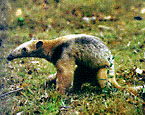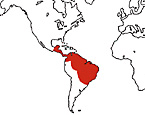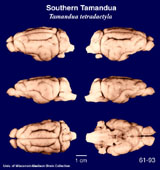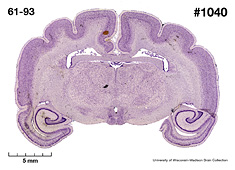|
Southern
Tamandua (Collared Anteater)
(Tamandua tetradactyla) #61-93 |
||||
|
|
Physical
characteristics and distribution
|
|
The T.tetradactyla's nose is elongated (although much less so than the Giant Anteater's) and its eyes and mouth are small. The coat is bristly and brownish yellow in color, with black, red, and brown markings. The tail is partly prehensile and covered with hair for a third of its length. The end of the tail is completely hairless and covered with scales. The legs are strongly built and the front feet have four toes (hence its species name "tetradactyla" meaning "four toes"). The third toe is the largest and strongest, with a very long claw. The hind feet have five toes. T.tetradactyla can be over two feet long (~535-880 mm), with another two feet (~400-590 mm) added on for its tail. It weighs between 10 and 15 lbs (2-7 kg). Its life span is up to 9 years long. T.tetradactyla feeds on ants, termites, beetles and insect larvae which it catches with its long, sticky tongue. Unlike the Giant Anteater, however, it can climb nimbly up trees in search of its prey. Gestation is 130-150 days. In spring, the female gives birth to a single offspring, and for a long period carries it clinging to her back or flanks. Tamandua tetradactyla is found in South America east of the Andes from Columbia, Venezuela, Trinidad, and the Guianas, south to Uruguay and N Argentina. Its habitats consist of wet and dry forests, including tropical rainforest, savanna, and thorn scrub.
|
|
Description
of the brain
|
|
Animal
source and preparation
|
|
All specimens collected followed the same preparation and histological procedure.
|
Other
Related Resources (websites and publications)
List of Specimens | Explore Collections | Brain Sections | Brain Evolution | Brain Development | Brain Circuitry | Brain Functions | Location and Use | Related Web Sites | Contact Us | Search MSU Database | Personnel | Home



